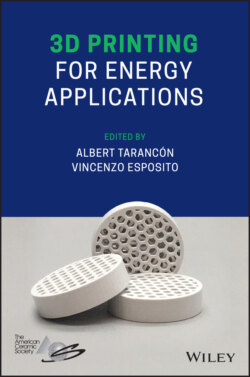Читать книгу 3D Printing for Energy Applications - Группа авторов - Страница 26
1.3 Direct Material Deposition 1.3.1 Powder and Wire Feedstock for Near‐Net‐Shape AM
ОглавлениеDirect Material Deposition (DMD) can be divided into two classes of AM processes based on the feedstock being powder or wire. The class of powder feedstock systems is called Directed Energy Deposition (DED), and with wire, the systems are classified underwire arc additive manufacturing (WAAM) [51]. In both cases, the deposition head consists of a power source (Laser/Wire arc) and a material deposition module to continuously add new material into the process. Often the deposition head is mounted on a five‐axis robot, and typically, there is an option to mix multiple materials in‐situ. The material flexibility in DMD processes makes them the most suitable for manufacturing functionally graded AM components. Theoretically, any additive process that allows adjustment of feedstock material mid‐build is viable. However, directed energy deposition (DMD) processes lend themselves best to functional grading due to the comparatively small feedstock losses as opposed to multi‐material PBF, since powder blends cannot be easily separated and recycled for reuse. Figure 1.4 shows a schematic of the DED process, wherein the deposition head is mounted on a five‐axis robot. Up to six materials can be used simultaneously in the setup. Laser deposited materials experience a complex thermal history marked by rapid solidification, high cooling rates, steep thermal gradients, and cyclic reheating and cooling from multiple laser passes. This can lead to the formation of nonequilibrium microstructures and significant variations in microstructure from layer to layer, as well as within individual layers. Hence, an online process‐control is achieved with the help of an in‐axis thermal camera that ensures similar thermal gradients in each new layer.
Hybrid Additive Manufacturing (HAM) combines the cost‐saving additive process with the dimensional accuracy of subtractive CNC machining [53]. When a metallic part is additively manufactured by direct material deposition, HAM allows the part to be machined after deposition occurs in the same system. This is largely different compared to the steps taken for conventional CNC techniques, where a block of a single material is placed into a CNC machine and is subjected to extensive subtractive processes to create a final part. A large amount of material waste is generated from the excess material during milling, which translates directly to manufacturing cost and environmental impact. With HAM, however, the initial block material is no longer present because the operator is building the part near net shape by direct deposition, requiring only surface finishing where necessary and creating little material waste. The presence of the deposition head on a robot‐arm leads to a straightforward integration with CNC to convert a typical DMD process into HAM. Several FGM applications are found for DED as compared to WAAM because the near‐net‐shape resolution of DED is small enough to have a much wider range of complex functional applications in the as‐built condition. Further, DED is better at repairing complex components due to the coaxial powder feeding mechanism and faster cooling rate, which allows for material deposition against gravity. The further sections thus focus on DED toward making functionally graded materials.
Figure 1.4 Schematic of powder feedstock based Direct Energy Deposition (DED) system installed at Force technology [52].
Photo credit: Venkata K Nadimpalli.
